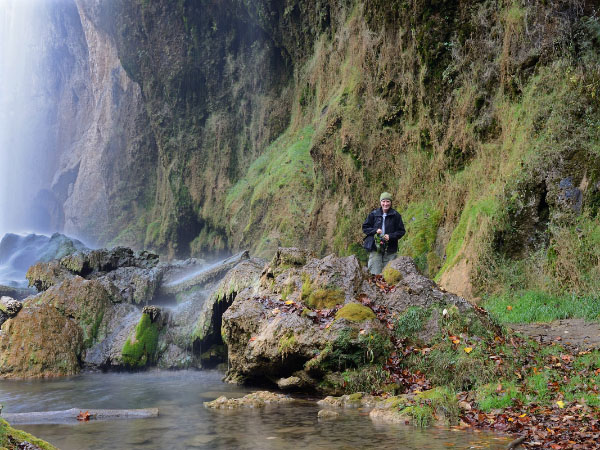

Virginia Department of Conservation and RecreationAn official website of the Commonwealth of Virginia Here's how you knowAn official websiteHere's how you know

Virginia Department of Conservation and RecreationAn official website of the Commonwealth of Virginia Here's how you knowAn official websiteHere's how you know
 Department of Conservation and Recreation
Department of Conservation and Recreation
 Table of Contents
Table of ContentsSpray Cliffs
Spray cliff communities occur on constantly wet rock faces within the spray or splash zones of waterfalls, or on sheltered cliffs saturated with permanent seepage. A few examples, scattered over the entire mountain region of the state, are known from qualitative reports. Three of the best examples are the travertine rocks faces at Falling Spring Falls (Allegheny County) and the sandstone faces at Abrams Falls (Washington County) and Cascades (Giles County). These have been sampled by bryologists, although only Cascades has received intensive work. At this time, very little can be said about the ecological dynamics or floristic composition of these occurrences. Based on observations, mosses and liverworts are usually the dominant plants, with vascular species more sparsely rooted in crevices and on moss- or humus-covered shelves. Among the most characteristic and widespread vascular plants are brook saxifrage (Boykinia aconitifolia), small enchanter's night-shade (Circaea alpina ssp. alpina), small-flowered alumroot (Heuchera parviflora var. parviflora), rock clubmoss (Huperzia porophila), saxifrages (Micranthes caroliniana and Micranthes micranthidifolia), mountain meadow-rue (Thalictrum clavatum), and various lithophytic ferns.
Among the dominant or characteristic bryophytes documented at Virgina spray cliffs are (Anomodon rostratus, Brachythecium rutabulum, Brachythecium salebrosum, Conocephalum salebrosum, Cratoneuron filicinum, Didymodon tophaceus, Dumortiera hirsuta, Gymnostomum aeruginosum, Hygroamblystegium fluviatile, Hygroamblystegium tenax, Hymenostylium recurvirostre, Hypnum lindbergii, Marchantia polymorpha, Philonotis muhlenbergii, and Plagiomnium ellipticum, and Ptychostomum pseudotriquetrum.
Very few waterfalls in Virginia are large and constant enough to provide requisite conditions for spray cliff communities. Good examples, therefore, should be high priorities for protection. A full understanding of Virginia's spray cliff vegetation and its relationship to similar vegetation further south in the Appalachians will require comprehensive bryological inventories.Reference: Diecchio and Walton (2003)
Click here for more photos of this ecological community group.
 © DCR-DNH, Gary P. Fleming.
© DCR-DNH, Gary P. Fleming.

